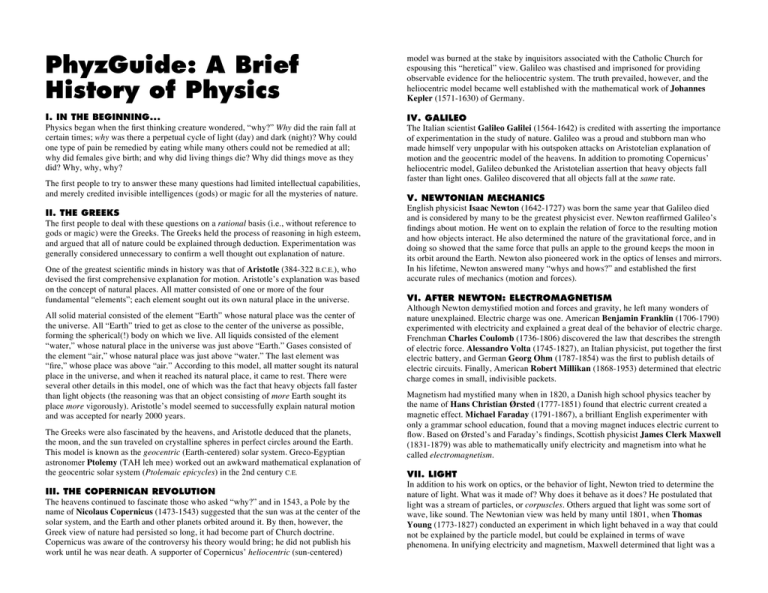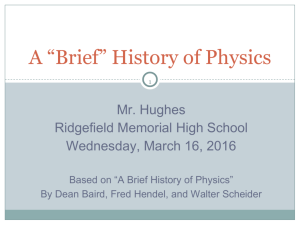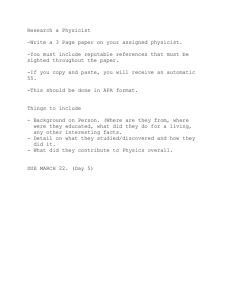
PhyzGuide: A Brief
History of Physics
model was burned at the stake by inquisitors associated with the Catholic Church for
espousing this “heretical” view. Galileo was chastised and imprisoned for providing
observable evidence for the heliocentric system. The truth prevailed, however, and the
heliocentric model became well established with the mathematical work of Johannes
Kepler (1571-1630) of Germany.
I. IN THE BEGINNING...
Physics began when the first thinking creature wondered, “why?” Why did the rain fall at
certain times; why was there a perpetual cycle of light (day) and dark (night)? Why could
one type of pain be remedied by eating while many others could not be remedied at all;
why did females give birth; and why did living things die? Why did things move as they
did? Why, why, why?
IV. GALILEO
The Italian scientist Galileo Galilei (1564-1642) is credited with asserting the importance
of experimentation in the study of nature. Galileo was a proud and stubborn man who
made himself very unpopular with his outspoken attacks on Aristotelian explanation of
motion and the geocentric model of the heavens. In addition to promoting Copernicus’
heliocentric model, Galileo debunked the Aristotelian assertion that heavy objects fall
faster than light ones. Galileo discovered that all objects fall at the same rate.
The first people to try to answer these many questions had limited intellectual capabilities,
and merely credited invisible intelligences (gods) or magic for all the mysteries of nature.
II. THE GREEKS
The first people to deal with these questions on a rational basis (i.e., without reference to
gods or magic) were the Greeks. The Greeks held the process of reasoning in high esteem,
and argued that all of nature could be explained through deduction. Experimentation was
generally considered unnecessary to confirm a well thought out explanation of nature.
One of the greatest scientific minds in history was that of Aristotle (384-322 B.C.E.), who
devised the first comprehensive explanation for motion. Aristotle’s explanation was based
on the concept of natural places. All matter consisted of one or more of the four
fundamental “elements”; each element sought out its own natural place in the universe.
All solid material consisted of the element “Earth” whose natural place was the center of
the universe. All “Earth” tried to get as close to the center of the universe as possible,
forming the spherical(!) body on which we live. All liquids consisted of the element
“water,” whose natural place in the universe was just above “Earth.” Gases consisted of
the element “air,” whose natural place was just above “water.” The last element was
“fire,” whose place was above “air.” According to this model, all matter sought its natural
place in the universe, and when it reached its natural place, it came to rest. There were
several other details in this model, one of which was the fact that heavy objects fall faster
than light objects (the reasoning was that an object consisting of more Earth sought its
place more vigorously). Aristotle’s model seemed to successfully explain natural motion
and was accepted for nearly 2000 years.
The Greeks were also fascinated by the heavens, and Aristotle deduced that the planets,
the moon, and the sun traveled on crystalline spheres in perfect circles around the Earth.
This model is known as the geocentric (Earth-centered) solar system. Greco-Egyptian
astronomer Ptolemy (TAH leh mee) worked out an awkward mathematical explanation of
the geocentric solar system (Ptolemaic epicycles) in the 2nd century C.E.
III. THE COPERNICAN REVOLUTION
The heavens continued to fascinate those who asked “why?” and in 1543, a Pole by the
name of Nicolaus Copernicus (1473-1543) suggested that the sun was at the center of the
solar system, and the Earth and other planets orbited around it. By then, however, the
Greek view of nature had persisted so long, it had become part of Church doctrine.
Copernicus was aware of the controversy his theory would bring; he did not publish his
work until he was near death. A supporter of Copernicus’ heliocentric (sun-centered)
V. NEWTONIAN MECHANICS
English physicist Isaac Newton (1642-1727) was born the same year that Galileo died
and is considered by many to be the greatest physicist ever. Newton reaffirmed Galileo’s
findings about motion. He went on to explain the relation of force to the resulting motion
and how objects interact. He also determined the nature of the gravitational force, and in
doing so showed that the same force that pulls an apple to the ground keeps the moon in
its orbit around the Earth. Newton also pioneered work in the optics of lenses and mirrors.
In his lifetime, Newton answered many “whys and hows?” and established the first
accurate rules of mechanics (motion and forces).
VI. AFTER NEWTON: ELECTROMAGNETISM
Although Newton demystified motion and forces and gravity, he left many wonders of
nature unexplained. Electric charge was one. American Benjamin Franklin (1706-1790)
experimented with electricity and explained a great deal of the behavior of electric charge.
Frenchman Charles Coulomb (1736-1806) discovered the law that describes the strength
of electric force. Alessandro Volta (1745-1827), an Italian physicist, put together the first
electric battery, and German Georg Ohm (1787-1854) was the first to publish details of
electric circuits. Finally, American Robert Millikan (1868-1953) determined that electric
charge comes in small, indivisible packets.
Magnetism had mystified many when in 1820, a Danish high school physics teacher by
the name of Hans Christian Ørsted (1777-1851) found that electric current created a
magnetic effect. Michael Faraday (1791-1867), a brilliant English experimenter with
only a grammar school education, found that a moving magnet induces electric current to
flow. Based on Ørsted’s and Faraday’s findings, Scottish physicist James Clerk Maxwell
(1831-1879) was able to mathematically unify electricity and magnetism into what he
called electromagnetism.
VII. LIGHT
In addition to his work on optics, or the behavior of light, Newton tried to determine the
nature of light. What was it made of? Why does it behave as it does? He postulated that
light was a stream of particles, or corpuscles. Others argued that light was some sort of
wave, like sound. The Newtonian view was held by many until 1801, when Thomas
Young (1773-1827) conducted an experiment in which light behaved in a way that could
not be explained by the particle model, but could be explained in terms of wave
phenomena. In unifying electricity and magnetism, Maxwell determined that light was a
form of electromagnetism: an electromagnetic wave. However, the argument was not
over. With the rise of quantum theory came the wave-particle duality which not only
describes electromagnetic radiation as having properties of both waves and particles, but
also specifies that all objects—large and small—have wave characteristics. Much of this
work is credited to Austrian physicist Erwin Schrödinger (1887-1961) and French
physicist Louis de Broglie (1892-1987).
VIII. RELATIVITY
Until 1881, physicists believed that there was a substance that pervaded the universe
called æther. Æther was thought to be the stuff through which electromagnetic waves
travelled (in the same sense that sound waves travel through air). In 1881, however,
American physicist Albert Michelson (1852-1931) and chemist Edward Morley
(1838-1923) conducted a clever experiment that showed that æther did not exist.
German-born American physicist Albert Einstein’s (1879-1955) Theory of Relativity is
based, somewhat, on the fact that æther does not exist. It had previously been thought that
the Earth was a body that moved through the æther, which was at rest in an absolute sense.
A fundamental principle of relativity is that there is no absolute frame of reference that is
at rest. For example, you may think you are motionless right now; but you are moving on
a spinning Earth, which also moves around the sun, which is a star moving around the hub
of the Milky Way galaxy, which is moving through space as the universe expands. The
details of Einstein’s relativity actually debunks much of Newtonian mechanics, but only
for objects moving very fast (250,000,000mph or faster). Most importantly, relativity
explains that mass and energy are two forms of the same thing, and even gives the
mathematical relationship of the two in the most famous equation of the twentieth century:
E = mc2.
IX. QUANTUM THEORY
In 1918, German physicist Max Planck (1858-1947) was awarded the Nobel Prize for a
theory he put forward in 1900 “in an act of sheer desperation,” as he put it. He had been
analyzing the light emitted by heated objects and noticed the data wasn’t matching the
expected results. It seemed that the energy in the light did not increase or decrease in a
smooth, continuous manner, but rather it increased or decreased in steps, as if the energy
came in discrete packets. Planck called these tiny energy packets quanta and suggested
that all light was emitted in specific numbers of quanta. Many physicists scoffed, but
Einstein accepted it and in 1905 advanced quantum theory by contending that light was
also absorbed in discrete quanta.
The next advance in quantum theory came in 1913 when Danish physicist and former
member of the championship All-Danish soccer team, Neils Bohr (1885-1962), advanced
a model of the Hydrogen atom based on the new quantum theory. He saw that quantum
theory predicted the energy of light emitted by heated hydrogen atoms; they could emit
light in specific, definite energies—not in a continuous spectrum. Bohr’s model of the
atom replaced the classical Rutherford atom, which depicts the atom as a miniature solar
system with a nucleus at the center and electrons circling outside.
Quantum mechanics do not fix cars, or even quantums; rather it is a field in which
quantum principles are applied to the inner workings of atoms. One of the
accomplishments in quantum mechanics is the Pauli exclusion principle, advanced by
Austrian physicist Wolfgang Pauli (1900-1958) in 1925. The Pauli Exclusion Principle
excludes two electrons in the same atom from having the same four quantum
characteristics. You can probably imagine an “identity exclusion principle” which states
that within a given household, no two people can have the same identity characteristics:
name, age, height, and weight: Bob Sr. and Bob Jr. have the same name, but different age,
height and weight. Bob Jr. might have a twin brother who has the same age, height and
weight, but his name is Bill, and so on.
Another famous finding of quantum mechanics is the Heisenberg Uncertainty Principle. In
1927, Werner Heisenberg (1901-1976) of Germany stated that it is impossible to know
both the position and speed of an electron at the same time. Any method of measuring the
electron’s position would change the electron’s speed; measuring the electron’s speed
alters its position. It is as if you walked into a dark room with a flashlight, looking for your
car keys. But as soon as the light from your flashlight hits an object, the object is blown
out of its position as if struck with a great force. You spot the car keys, but immediately
they are blasted across the room to a new position.
X. THE GRAND UNIFICATION
Among the few “rules of the universe” are the rules regarding the four fundamental forces:
gravity, electromagnetism, nuclear weak and nuclear strong. A Grand Unified Theory
(GUT) is one that shows how all four descended from a “superforce” that existed only in
the earliest stage of the big bang. Remember that Maxwell had unified what had been
thought were two separate forces: electricity and magnetism. Recently, Pakistani Abdus
Salam (1926) and Americans Sheldon Glashow (1932) and Steven
Weinberg (1933) have advanced a theory connecting electromagnetism and the
weak nuclear force into the “electroweak” force. Unifying the other forces with gravity
seems to be the most difficult hurdle in GUT thinking today.
EPILOGUE
So there you have it, a quick tour through the history of physics. It is by no means
comprehensive; many exciting aspects were left out, but it does cover the central advances
in our understanding of the universe. Regarding the caveman’s questions in section I, our
understanding of physics in the field of atmospheric science and meteorology allow us to
understand and predict weather patterns. We have long since understood the planetary
mechanics that result in night and day. Advances in the science of biology, which is based
in chemistry, which is based in physics, have led us to an understanding of biological
processes and medicine.
The ultimate goal of physics is to understand completely how the universe works. I will
leave you with a quote from physicist/astronomer Carl Sandage:
“People have attacked me because I do only one thing. But that
one thing is to try to figure how the world is put together. The
world is incredible—just the fact that you and I are here, and
that the atoms of your body were once part of stars. They say
I’m on some sort of religious quest, looking for God; but God
is the way it’s put together. Anyway,” he laughed, “I’m a nut,
you know. Crazy.”
by Dean Baird, Fred Hendel, and Walter Scheider
The Book of Phyz
© Dean Baird. All rights reserved.
8/3/14


